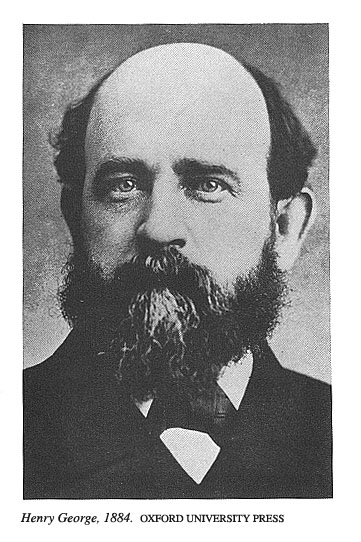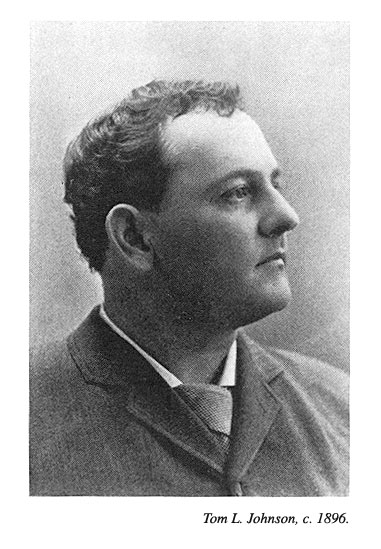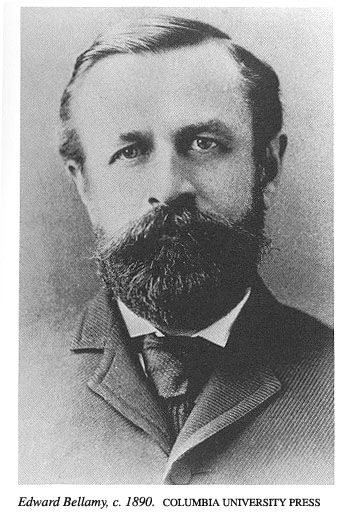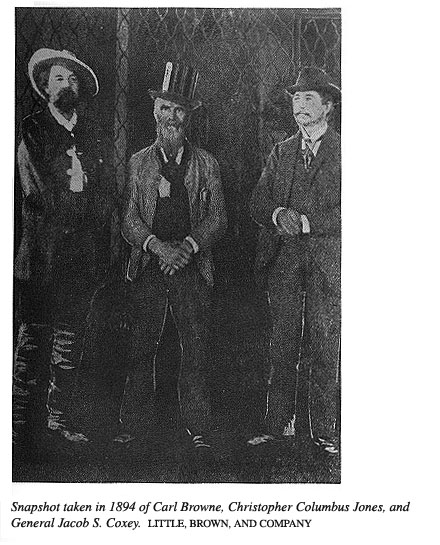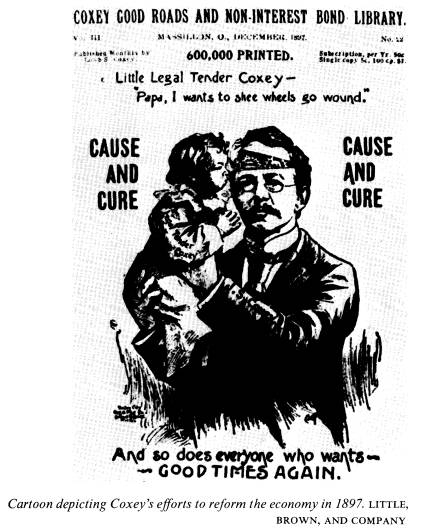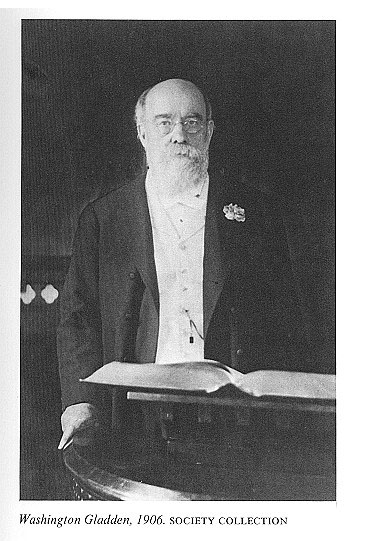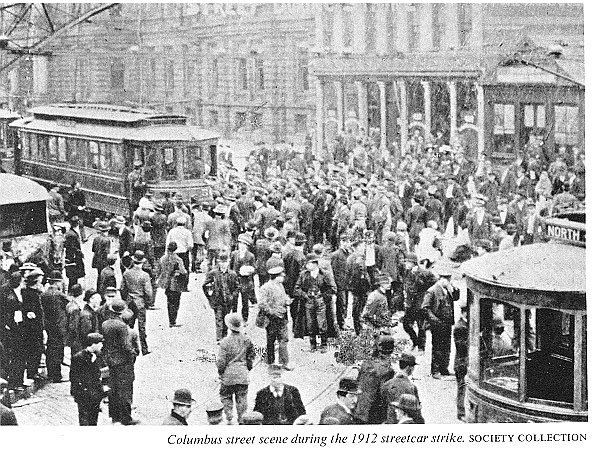Ohio History Journal
LYSLE E. MEYER
Radical Responses to Capitalism
in Ohio Before 1913
By the time Ohio entered the last two
decades of the nineteenth century, various
forms of radicalism had already emerged
which challenged the basic tenets of the
prevailing style of life. A number of
communitarian settlements had been estab-
lished in the state, beginning with the
first Shaker experiments, Union Village in
1805 and Shakertown in 1806. The
Wurttemberg Separatists, soon after, founded
the Zoar community in 1817. Some of
these settlements represented apocalyptic
sectarian communism with emphasis on
withdrawal from the neighboring world for
the purpose of religious and social
regeneration. As such, they were the outgrowths
of religious movements ultimately
traceable to the Protestant Reformation. All re-
jected individualism as offering no hope
to a troubled world.1 The social and eco-
nomic aspects of the Shaker program, for
instance, included the following considera-
tions:
The great inequality of rights and
privileges which prevails so extensively throughout the
world, is a striking evidence of the
importance of a reformation of some kind . . . .
The United Society of Believers (called
Shakers) was founded upon the principles of
equal rights and privileges, with a
united interest in all things, both spiritual and temporal. . . .2
Not all communitarian experiments were
basically religious movements; some
were clearly secular and designed
primarily for social reform. Perhaps the best
examples of the secular type were those
based upon the theories of the European
utopian socialists Robert Owen and
Charles Fourier. After achieving fame as
founder of the model factory town of New
Lanark in Scotland, Owen, a wealthy,
self-made British industrialist,
established a community in New Harmony, Indiana,
in 1825. Here he hoped to put into
practice his beliefs in the equality of men and
the necessity for community ownership of
goods. It was Owen's view that controlled
environmental improvement was the key to
social progress. Although New Harmony
was unsuccessful, due largely to
inadequate planning and supervision, Owen's
1. Arthur E. Bestor, Jr., Backwoods
Utopias: The Sectarian and Owenite Phases of Communitarian
Socialism in America, 1663-1829 (Philadelphia, 1950), 5-7; Albert T. Mollegen,
"The Religious Basis of
Western Socialism," in Donald Drew
Egbert and Stow Persons, eds., Socialism and American Life
(Princeton, 1952), I, 114.
2. Calvin Green and Seth Y. Wells, A
Summary View of the Millennial Church, or United Society of
Believers, Commonly Called Shakers .
. . (Albany, 1848), 2-3.
Mr. Meyer is chairman, department of
history, Moorhead State College, Moorhead, Minnesota.
194
OHIO HISTORY
dream inspired other similar experiments
in America. Indeed, even before New
Harmony took shape, some other reformers
assembled a community at Yellow
Springs, Greene County, in 1825. Within
a year and a half this effort failed, but
other Owenites had slightly more success
with the Kendal community in Stark
County from 1826 to 1829. And in the
southwestern part of the state during the
same period still other like-minded
communitarians, such as the Rational Brethern
of Oxford and the Swedenborgians, had
their brief flings at creating better worlds
in microcosm.3
Fourier, the French visionary, proposed
a model society which would abolish
evil through a transformation of the
social environment but would use the phalanx
to accomplish the goal. The phalanx was
a social unit within which there would be
communal living, free choice of
occupations, and easy mobility from one occupation
to another but not economic equality.
The phalanxes were to be cooperative associ-
ations in rural settings where annual
profits would be divided in ratio of five-twelfths
to the laborers, four-twelfths to the
investors of capital, and three-twelfths to the
intellectuals or imaginative leaders who
provided the ideas.4 Over forty schemes,
based more or less on the phalanx plan,
were put into operation in the United
States, four of them in Ohio during the
1840's. The Fourierists of Ohio, however,
had no more success than the followers
of Robert Owen.
Although these groups, both religious
and secular, never attracted large num-
bers into their ranks, it would be a
mistake to discount completely their effect on
the attitudes of others. By means of
books and pamphlets many persons received
information about their ideas and
activities. In some cases, such as the Zoar com-
munity, outstanding management and high
quality production units focused atten-
tion on the project, giving the group an
influence on its neighbors out of proportion
to its size.
Other radical currents passed through
Ohio after the Civil War, several of them
lingering on as a result of certain
long-standing conditions. Liberal Republicanism,
the Cheap Freight Railway League, the
Free-Trade League, and Greenbackism
were some of the responses generated in
the Midwest by reformers and specific
interest groups. The Greenback movement,
of particular importance, represented
strong support on the part of farmers
and debtor classes in Ohio for inflationary
measures by the Federal Government.
Eventually, in 1877, these increasing demands
for financial relief were brought to a
head with the formation in Columbus of an
"Independent Greenback Club"
which later became the Greenback party. In addi-
tion to an altered monetary policy, the
Greenbackers called for governmental re-
strictions on all corporations and
demanded Federal programs to insure fuller
employment as well as a graduated income
tax--in short, economic equality for
all segments of the population.5
The foregoing expressions of discontent
were rurally based. During the same
period conditions in the cities also
encouraged unrest and dissatisfaction with the
status quo. The rapid growth after the Civil
War of the principal cities engendered
the explosive political and social
problems which were to arouse ever-increasing
3. Bestor, Backwoods Utopias, 160-201,
205-213; Mark Holloway, Heavens on Earth: Utopian Com-
munities in America, 1680-1880 (New York, 1966), 104-106; Wendall P. Fox, "The
Kendal Community,"
Ohio Archaeological and Historical
Publications, XX (1911), 176-219.
4. Holloway, Utopian Communities, Chapter
8.
5. Chester McArthur Destler,
"Western Radicalism, 1865-1901: Concepts and Origins," Mississippi
Valley Historical Review, XXXI (December 1944), 339-341; Philip D. Jordan, Ohio
Comes of Age, 1873-
1900 (Carl Wittke, ed. The History of the State of Ohio, V,
Columbus, 1943), 154-155.
Responses to Capitalism 195
cries for reform in Cincinnati,
Cleveland, and Columbus toward the end of the
century. As industry progressed and
business expanded, the cities attracted greater
numbers from rural areas and from
overcrowded countries of Europe. The labor
movement gradually became a more
significant element for reform in the larger
urban areas amid wretched working
conditions and oppressive policies of employers.
Working women and children were
especially ill-treated and their situation con-
tinued to demand rectification. Through
the seventies, hardship was rife among
city workers; wage cuts, unsuccessful
strikes, and severe unemployment were the
lot of Ohio's labor.6
Scientific socialism, the doctrine of
Marx and Engels, was an imported ideology
which had come to the United States with
European immigrants. The German
newcomers were the principal supporters
of this type of socialism in the 1850's.
The "forty-eighters," refugees
of revolutions in 1848, established the first socialist
clubs in the United States. After the
Civil War, the German influx continued, and
from 1881 to 1885 Germans represented
the largest single group of annual arrivals
to the United States and to Ohio. In the
census of 1880, Cincinnati showed the
largest German population in the
state--greater, in fact, than that of Cleveland,
Columbus, and Toledo combined.7
The first American socialist
organizations were sections of the Marxist Interna-
tional Working Men's Association and
were set up shortly after the Civil War. By
1872 there were about thirty sections
with five thousand members of the First
International in the United States.
Lassallean socialists, who differed from the Marx-
ists in that they tended to ignore the
labor union movement and concentrate
exclusively on the formation of workers'
political parties, founded the "Social-
Democratic Party of North America"
in 1874. These two antagonistic organizations
existed concurrently until 1876, when
they merged into the new Working Men's
party of the United States. The new
party had a Marxist platform but was directed
by Lassalleans. Conflict continued
between the two wings of the party, and the
Lassalleans won complete control in
1877, changing the name of the group to the
"Socialist Labor Party of North
America."8
The new party concentrated its efforts
on mobilizing the working class to vote. It
was, in fact, the first socialist party
in the United States that was intended for par-
ticipation in national elections. Local
and state elections gave the Socialists some
successes from 1876 to 1878, as the
nation still smarted from the Panic of 1873.
Party membership rose from 3000 to
10,000 in that period. Specific local conditions
also assisted the Socialists. In the
municipal elections in Cincinnati, for instance, the
party won 9000 votes in 1877 as a result
of the serious strikes preceding the elec-
tions, but this artificial boom was soon
over and the vote the next year was a meager
500. This great fluctuation can be
explained partly as the result of Cincinnati Social-
ists' failure to build any ties with the
trade unions in that city. Generally, member-
ship in the party as a whole grew in the
late seventies, but, as some degree of
prosperity returned to the country after
1879, the party rolls shrank, the national
6. Eugene H. Roseboom and Francis P.
Weisenburger, A History of Ohio (Columbus, 1956), 228-229.
7. Ira Kipnis, The American Socialist
Movement, 1897-1912 (New York, 1952), 6-7; Ohio, Annual
Report of the Secretary of State,
1885. p. 888; United States Bureau of
the Census, Immigrants and
Their Children 1920, Census Monographs VII (1927), 395.
8. Kipnis, American Socialist
Movement, 7-10. Ferdinand Lassalle (1825-1864) was the founder of
the German Social Democratic movement.
He emphasized the importance of political action toward
such goals as universal suffrage, but he
eschewed all violence.
196 OHIO
HISTORY
total being about 1500 members in 1880,
of whom only ten percent were native
Americans.9
Organization and expansion of the party
in the 1880's was difficult because inter-
nal party strife increased. Since trade
union forces within the Socialist ranks had
enjoyed no tangible results from limited
election successes, they wanted to give all
their attention to union activity.
Other, more extreme factions, believed that direct
action was necessary; these elements
increasingly joined emerging anarchist groups.
Not surprisingly, the dissension
prevented effective electioneering for socialist pro-
grams, with the result that the party
supported Greenback candidates for the presi-
dency in 1880, evidently hoping to
capitalize on some of that organization's
spectacular success in 1878. The
disastrous failure of the Greenbackers in 1880 as
well as their own internal troubles,
caused the Socialists to abstain from the 1884
election. Even in 1888, although an
independent ticket was put forward, candidates
were run only in New York.10
All through the eighties the Greenback
party campaigned in Ohio and had pro-
labor planks in its platform.11 The
Greenbackers made "Labor" part of their title in
1883 and the Greenback Labor party was
born. Faced with such competition, the
Ohio Socialist Labor party found itself
working with the Greenbackers, supporting
their local candidates while becoming
less active and influential in its own cause.
Socialists might have had a brief local
appeal in connection with particular labor
disputes, such as the serious Hocking
Valley coal strike of 1884, but their popularity
was short-lived.
Among other obstacles to Socialists'
progress at this time was the fact that the
party was composed predominately of
foreigners and had few English-speaking
organizers to work in the state. The
only English-language Socialist paper in Ohio
was moved from Cincinnati to Chicago
after the severe party defeat in 1878 in that
major Ohio city. Also of concern to the
Socialists during the early 1880's was the
challenge from the anarchist ranks. The
increasingly successful appeal of this im-
ported Russian ideology was considered
detrimental to Socialist interests in urban
centers. By 1885 there were some
English-speaking groups in Cleveland and Cin-
cinnati that were affiliated with the
Black International (Mikhail Bakunin's Anarch-
ist International Working People's
Association) as well as an indefinite number of
foreign language units. The competition
between the Socialists and anarchists was
resolved in favor of the Socialists as a
result of the infamous Haymarket Massacre
of 1886, in which a group of anarchists
was accused of throwing a bomb that caused
heavy casualties among a Chicago police
unit. After this bloodshed the Socialist
party was able to increase the number of
its sections in most of the midwestern
states.12
During this same period another response
evoked by the socioeconomic system
was the Single Tax movement conceived by
Henry George (1839-1897). In 1871
the former newspaper man published a
forty-eight page pamphlet Our Land and
Land Policy, which was expanded into a book length presentation, Progress
and
Poverty, in 1879. In these works George advocated the
destruction of land monopoly
9. Ibid.; John R. Commons and others, History of Labor in the
United States (New York, 1918),
II, 282; Daniel Bell, "The
Background and Development of Marxian Socialism in the United States,"
in Egbert and Persons, Socialism, I,
237.
10. Kipnis, American Socialist
Movement, 10-11; George Harmon Knoles, "Populism and Socialism
with Special Reference to the Election
of 1892," Pacific Historical Review, XII (1943), 297-298.
11. Appletons' Annual Cyclopaedia . .
. 1881, VI, 701-702.
12. Commons, History of Labor, II,
282, 300, 390.
|
|
|
as a solution to the nation's economic ills. He would accomplish his purpose by shifting all taxes from labor and the products of labor to land. Land was considered to be the essential commodity for taxable purposes since he saw it as the source of all employment. To correct the unequal distribution of wealth as well as cure the abuse of recurring business depression the Single Tax on the value of land, irres- pective of improvement, should be adopted. Such a tax would make "land specu- lation unprofitable, land monopoly impossible, and so open to the possessors of the power to labor the ability of converting it [the ability to work] by exertion into wealth or purchasing power" and thus eliminate the preposterous situation in which "a man able to work suffers from want of things that work produces."13 George's writings were widely distributed, and by 1886 he was asked to run for mayor by the Central Labor Union of New York City. He was nominated, he said, "because it was believed that I best represented the protest against unjust social 13. Henry George, Progress and Poverty: An Inquiry into the Cause of Industrial Depressions and of Increase of Want with Increase of Wealth, The Remedy (Cincinnati, 1905), 263-294; Henry George, "Causes of Business Depression," essay by George based on his book Progress and Poverty, reprinted by the Robert Schalkenbach Foundation, New York, 1930, pp. 12-13. |
|
|
|
Tom L. Johnson, c. 1896. conditions [inflicted on the Irish workingmen] and the best means of remedying them." Pitted against him in a hotly contested campaign were Abram S. Hewitt, Democrat, and Theodore Roosevelt, Republican. The official result of the balloting was Hewitt, 90,552; George, 68,110; Roosevelt, 60,435.14 Even though George lost in the election, he gained widespread publicity and many converts to his ideas. One such person was the thirty-one year old business- man Tom L. Johnson, who would become Ohio's Congressman from 1891 to 1895 and be mayor of Cleveland, 1901-1909. In an effort to publicize George's ideas, Johnson in 1892 led a small group of Single Taxers in the House in a project to read into the Congressional Record another of the reformer's books, Protection or Free Trade, as part of their remarks on the tariff question then at issue. The 332 page book was subsequently mailed, without cost, to Single Taxers (more than 1,200,000) under the franking privilege, after printing costs had been paid by those wishing to circulate the information. Also, in Ohio, a Single Tax League was formed which claimed that a total of forty-one towns had Single Tax clubs or committees. It published a paper that carried attacks on tariffs and taxes along with appropriate 14. Arthur Nichols Young, The Single Tax Movement in the United States (Princeton, 1916), 95-107. |
|
|
|
Edward Bellamy, c. 1890. COLUMBIA UNIVERSITY PRESS quotes from George, Herbert Spencer, and Thomas Huxley. From an office in Cleve- land the league mailed to members the names of likely prospects for its propaganda barrage and weekly missives were sent to the contacts.15 When Tom Johnson became mayor of Cleveland, he continued his allegiance to George's ideas and the struggle against "Privilege." This he defined as "the ad- vantage conferred on one by law," and identified five major classes of privileges: land monopolies, taxation monopolies, transportation monopolies, municipal monop- olies, and patent monopolies, emphasizing that "the greatest of all governmental favors or special privileges is land monopoly, made possible by the exemption from taxation of land values." Johnson explained carefully what he meant by "land value" in a speech to farmers that was published and widely distributed in pamphlet form by the Joseph Fels Fund of America in 1908. To Johnson the "single-tax" would not be on the amount of land a person owned, which would unjustly penalize farm- ers, but on "land values" or value due to improvements or mineral wealth of all kinds. The burden of taxation would then be lifted from farmers and workingmen 15. Ibid., 142-145; Tom L. Johnson, My Story, edited by Elizabeth J. Hauser (New York, 1915), 52; Single Tax (Cincinnati), March 15, 1890. |
200
OHIO HISTORY
and be placed on those who were
profiting most from the monopolies. Even though
the Single Taxers were not able to pass
direct legislation in the Ohio Assembly,
efforts by Johnson and like-minded
disciples of Henry George helped swell the
ranks of those clamoring for reforms, especially among
the middle class in Ohio.16
Another radical response which caught
the imagination of Ohioans in the late
nineteenth century for improvement of
the economic system was the American-born
socialist movement known as
"Bellamy Nationalism." This was the name given, at
the suggestion of William Dean Howells,
by Edward Bellamy to the utopian system
portrayed in his novel, Looking Backward,
2000-1887. Published in January 1888,
200,000 copies had been sold by December
1889. In place of the laissez faire prac-
tices of the Gilded Age, Bellamy
advocated a paternalistic state that would main-
tain an economy of abundance in which
all citizens, even those infirm and insane,
would share equally. To achieve this
goal he advocated such reforms as municipal
ownership of water, gas, electricity,
and street railways; government ownership of
railroads, telegraph, and telephone;
government regulation and eventual ownership
of all mines; the initiative, the
referendum, and minority representation; and several
other reforms as well.
Bellamy's ideas were initially advanced
through clubs established by his followers.
The first Nationalist club in Ohio was
formed in Cincinnati in 1889, one year after
the first had been established in
Boston. Thereafter clubs were founded by middle-
class elements in Cleveland, Akron,
Columbus, and Findlay, and other groups ex-
isted, such as the Dayton Citizens' Club
and the Cleveland Citizens' Alliance, which
espoused principles related to those of
Nationalism. In 1893 the Nationalists, in
cooperation with the National Farmers'
Alliance, formed a new political party, the
Peoples Party of Ohio or Populist party.
Nationalist influence in Ohio reached its
climax in 1894 when the Labor party
joined in a coalition with the Populist party.
At a convention in Columbus that year
the platform adopted was a composite,
including, in addition to those
Nationalist aims cited above, the following
Nationalist-oriented planks: collective
public ownership of all means of production
and distribution, passage of fair labor
laws, currency reform, and female suffrage;
it also included a vaguely worded
single-tax plank denouncing land monopoly.
After a poor showing at the polls in
1894, the Nationalist movement declined, and
in 1896 the Populist party merged with
the Democratic party, leaving the Nation-
alist faction without coalition support.
The Nationalist clubs thereafter quickly dis-
appeared from Ohio, but it may be
assumed that more than one person found
Socialism via Bellamy Nationalism.17
Following the Panic of 1893, Ohio
experienced a depression. The spirit of unrest
was widespread and strikes were common
throughout the state. Unemployment was
high and no relief was in sight. In 1894
Jacob S. Coxey, an Ohio businessman-
politician, decided to do something
about this situation. He organized a so-called
"industrial army" of the
unemployed and marched to the nation's capital. The
march was to call attention to the
workers' distress and bring to the Government
16. Johnson, My Story, xxxv-xxxvi;
Johnson "Tom Johnson to Farmers," leaflet published by The
Joseph Fels Fund of America, Cincinnati,
n.d., n.p. For a fuller discussion of the work of Single Taxers
in Ohio, see Lloyd Sponholtz,
"The 1912 Constitutional Convention in Ohio: The Call-up and Non-
partisan Selection of Delegates,"
in this issue.
17. This discussion of the Bellamy
movement is based on William F. Zornow's article, "Bellamy
Nationalism in Ohio 1891 to 1896," Ohio
State Archaeological and Historical Quarterly, LVIII (April
1949), 152-170; Arthur E. Morgan, Edward
Bellamy (New York, 1944), 248, 276-277; Appletons'Annual
Cyclopaedia, 1894, 627; Ohio State Journal (Columbus), August 8,
16, 18, 1894.
|
|
|
pleas for Federal work projects to relieve the unemployment. Coxey's home town of Massillon, Ohio, was the starting point of the demonstration, but many partici- pants were from Cleveland and Chicago, and workingmen were added to the group along the way. In desperation men joined "The Commonweal of Christ." This was the name adopted by Carl Browne, one of the leaders, who fostered a religious aspect in the movement. One observer noted, nevertheless, that their minds were "unfortunately, fast grounded on socialism." It is likely that many of the discour- aged marchers returned home only to become associated with more radical ele- ments. Coxey, however, turned to the Populists for support and was run for gover- nor in 1895, receiving 50,000 votes. His early radicalism evidently did not leave an indelible mark on him, for in 1932, while mayor of Massillon, Coxey polled 75,000 votes in the Republican presidential preference primary.18 Another movement responding to the economic and social problems in Ohio was Christian socialism. This effort represented the new liberal tendencies in theology, 18. Donald L. McMurry, Coxey's Army: A Study of the Industrial Army Movement of 1894 (Boston, 1929), 32-53; Roseboom and Weisenburger, A History of Ohio, 248. See also Osman C. Hooper, "The Coxey Movement in Ohio," Ohio Archaeological and Historical Publications, IX (1901), 155-176. |
|
|
|
the basic concern for social justice, the influence of political economists, as well as the response to charges made against religion by Socialists, labor leaders, and others. Organized Christianity was said to be unconcerned with the many social ills bred by the industrial revolution in America. Leaders of the Social Gospel took up this challenge and tried to stem the tide of individualism which long had dominated Christian thinking. These leaders placed emphasis on the salvation of society in addition to that of individuals.19 Among the foremost exponents of the Social Gospel was Washington Gladden, pastor in Columbus from 1882 until his death in 1918. An indefatigable leader in the movement to keep Christianity a dynamic force in a changing industrial society, he took the offensive and questioned the premises of the Socialists and other re- formers. He attempted to show that the great problem of society was the proper relationship of man to his fellow-man; that man's relation to persons is deeper and diviner than his relation to things. Gladden appreciated the plight of the common man and did much to organize charity for relief of the suffering. The capitalist class 19. James Dombrowski, The Early Days of Christian Socialism in America (New York, 1936), 3-13. |
|
|
|
was told to recognize the good sense in helping labor to become prosperous so that everyone would benefit, and the urban dwellers were told that responsibility for good city government was theirs--they could not expect to receive benefits while they ignored their obligations. Gladden probably went further than most of his colleagues in his tolerant attitude toward Socialism; he held that "It is not wise to denounce Socialism and Socialists hotly and by wholesale, as so many do; it is much better to try to understand what they have to say and to discern the truth which is mingled with what we may admit to be their errors and exaggerations."20 Churchmen of many denominations participated in the Christian socialist move- ment in one degree or another, speaking out for reform or giving direct comfort to the unfortunate groups in society. During the 1890's an increasing number of theo- logical seminaries conducted special lecture courses on the relationship of the church to social problems. One such conference in 1894 on the subject, "Causes and Pro- posed Remedies for Poverty," was held at Oberlin College, sponsored by the Ameri- can Institute of Christian Sociology. This seminar was exceptional in that Socialist 20. Washington Gladden, Christianity and Socialism (New York, 1905), 51-53, 140, 230-231, 241-244. Gladden was well regarded in some Socialist papers; see The Socialist (Columbus), January 21, 1911. |
204
OHIO HISTORY
Thomas J. Morgan,
labor leader Samuel Gompers, and Rev. Washington Gladden
were asked to be
speakers stating their own cases. Professor John R. Commons,
the institute's
secretary, was on the faculty of Oberlin and was partly responsible
for that institution's
leadership in the teaching of social Christianity.21
In the period
1899-1914, Ohio rose from eighth to third in the nation in the in-
crease of number of
wage earners.22 This factor, when taken into consideration with
other conditions
previously mentioned, helps to account for the growth of the Social-
ist party during this
period. Ohio ranked third nationally in total Socialist vote in
1904 and was first by
1910. Lucas and Montgomery counties began to return rela-
tively more Socialist
votes by 1900, ahead of the Prohibition party, with both coun-
ties surpassing the
Franklin County Socialist vote that year. Candidates for president
that year were William
McKinley, William Jennings Bryan, and Eugene V. Debs.23
Indicative of growing
Socialist influence was the expansion of the Socialist press.
Not only did
additional newspapers appear but there was also a concerted attempt
to coordinate the
journalistic efforts of foreign-speaking and English-speaking sec-
tions of the party.
This question of coordination, of course, was part of the larger
problem of over-all
cooperation and consistency between language groups in the
movement. It was estimated
at one time that many foreign language sections of
the Socialist party in
Cleveland were practically isolated from the main units; they
were so much in
ignorance and behind the times that some of them still circulated
literature against
feudalistic institutions and called for separation of Church and
State.24
Socialist party
sections were organized throughout Ohio during the first decade
of the twentieth
century. Some of these groups in small hamlets such as Rawson,
Roseville, Aurora, and
Alpha had only half a dozen members, but all contributed
to the movement. Nor
was membership a simple automatic procedure. An applica-
tion had to be filed;
the applicant had to endorse without qualification the prin-
ciples of Socialism;
he had to be supported by a party member; and the prospective
member was then
examined by a committee. The party was specific in expressing
its determination not
to accept for membership anyone who was an "old ward-
heeler type." It
was claimed that such elements "could not break into the Socialist
party with an
ax." An incomplete breakdown of the delegates who made up the
1910 Ohio state
convention of the Socialist party showed the following backgrounds
represented:
Capitalists and small
businessmen 8
Professional men 11
Wage workers 115
Farmers 11
Also noteworthy was
the fact that 113 representatives were native born and only
seventeen foreign
born, giving clear indication of the success of the party's "Ameri-
canization"
process.25
In the drive to make
Socialism appeal to native-born Ohioans, the party organized
21. Dombrowski, Christian
Socialism, 72.
22. United States
Bureau of the Census, The Growth of Manufactures 1899-1923, Census
Monographs
VIII (1928), 84.
23. Socialist, April
13, 1912; Ohio, Annual Report of the Secretary of State, 1900, pp.
188-189.
24. Socialist Party, Proceedings
of the National Convention . . . Indianapolis, Indiana, May 12-18,
1912 (Chicago, 1912), 86.
25. Socialist, February 10, 17, March 2, 1912. Forty-nine of the workers
were labor union members.
Responses to Capitalism
205
programs similar to those sponsored by
many middle-class organizations. In Colum-
bus there was a Socialist Dramatic Club,
a Glee Club, and a Young People's Social-
ist League. Annual outings held in
Olentangy Park attracted as many as 20,000
Socialists, their families and friends
from all over the state. They were urged to
come and see the balloon ascensions and,
by congregating in large numbers, also
to "strike terror to [the] hearts
of plutes." In Mansfield, the party members occu-
pied themselves with the distribution of
leaflets and campaign literature, the mail-
ing of a party paper, the maintenance of
a Socialist library, and the arrangements
for lectures and speeches.26 These
activities probably represented the largest share
of the work done by the general
membership in the state. Thus it seems that be-
cause of the need to appeal to the
predominately bourgeois values of the American
working class, a type of "respectable"
radicalism was evolving which could attract
a wider following than could the parties
of the 1880's which were commonly asso-
ciated with the lunatic fringe.
Lectures were regular affairs in major
Ohio Socialist centers. In Columbus the
"Chicago Daily Socialist Lyceum
Course and Lectures" were offered. These com-
prised a series of evening talks and
discussions which were crowned on the final
night with a concert by the Socialist
Quartette Concert Company. Speakers were
invited to tour the state, and such
figures as Big Bill Haywood, Ella Reeve Bloor,
Eugene Debs, and Victor Berger made
appearances at various times and places in
Ohio. When the first-mentioned speaker
arrived he was heralded by the following
notices in the Columbus Socialist:
Come and Hear the Radical Speaker
of the Industrial Fight. He Talks
Common, Everyday, United States
Language.
If you are Timid or Middle Class,
you had Best Beware for He will Jar You.27
Haywood, the indefatigable organizer of
the Industrial Workers of the World,
evidently was a great drawing card,
providing a vicarious thrill to those who liked
to hear someone utter radical phrases
they could not bring themselves to express
in public.
The colleges and universities in the
state were not neglected. Socialist speakers
addressed the students at Ohio State
University on several occassions. In 1911,
"Comrade" Frank Bohn, as
associate editor of the International Socialist Review,
spoke in the university chapel under the
auspices of the school's Socialist Club.
Another Socialist spoke to "a
goodly number" on the Columbus campus and
described how the American workingman
was being exploited by the "money
power." Also, an Intercollegiate
Socialist Society, composed of representatives from
many schools across the country, had
clubs at Ohio Northern and Ohio Wesleyan.28
The Socialist party press broadcast
official views, continually disseminated propa-
ganda, and spoke out on local issues.
Taking the Columbus Socialist as an example
of expressed opinion, one can ascertain
how the party stood on important questions
of the time. Organized charity was
termed a "fake"; the workers, it was said, wanted
justice not charity. The contract system
for prison labor was a major object of
26. Ibid., May 27, 1911; February
17, 1912.
27. Ibid., January 14, 1911;
April 6, 1912.
28. Ohio State Lantern, October
11, 1911; Socialist, April 6, March 16, 1912.
|
|
|
Socialist ire in this period and was termed an abusive practice by which the state made millionaires. Southern anti-Negro legislation was attacked by Socialists, as were matters such as poor slaughtering inspection and bad streetcar service. Party support was voiced for the eight-hour day for women. Daily fare in a Socialist paper, of course, was a diatribe against the capitalists and monopolists in general, or certain employers and "slave drivers" in particular. Then, too, the capitalist press was usually taken to task for its poor coverage of Socialist activities.29 All this effort paid dividends, for some startling results were achieved by the Socialist party in 1910. In the race for governor with Judson Harmon and Warren G. Harding the leading Democratic and Republican contenders, the Ohio Socialists doubled their vote of 1908 and became the major Socialist state in the nation with 62,356 votes, followed by Pennsylvania with 59,630, Illinois with 49,896, and New York with 48,982. In 1911 Socialists were elected to city council posts in Columbus and to mayoralties in St. Marys, Salem, Cuyahoga Falls, Barberton, Lorian, Martins Ferry, Canton, Mt. Vernon, Fostoria, Toronto (Jefferson County), and Lima. In 1910 Columbus registered a Socialist vote more than twelve times that of 1908 and larger than that of Cleveland and Cincinnati combined. The victory in Columbus in 1911 was due to several factors. There had been serious labor disturbances in the city during 1909 and 1910. The most important was the streetcar strike during the latter year which occupied center stage for three months. The transit authority (Columbus Railway and Light Company) refused to recognize the employees' union and discharged some of its members for reasons interpreted by the union as retalia- tory. When initial attempts at arbitration threatened to break down, Republican 29. Ibid., March 4, February 18, 1911; December 24, 31, 1910. |
Responses to Capitalism
207
Governor Harmon readied the militia in
anticipation of trouble. Troops eventually
camped in several parts of the city,
despite the mayor's assurances that he could
control the situation without
soldiers.30
In typical fashion for the time,
strike-breakers were imported by the company,
and before the regular car operators
walked out they were ordered to teach these
"scabs" their jobs. Union men
protested that they had to train workmen who
"cursed unionism and bragged of
successful strikebreaking" elsewhere. Even the
police were shocked at the apparent
injustice of the company's stand, and about
fifty of their number mutinied, refusing
to obey commands to guard streetcars.
Columbus was exposed to numerous
incidents of violence during this bitter con-
frontation as cars and carbarns were
dynamited and troops, deputies, and detectives
clashed with strikers. Organized labor
further was enraged by a judicial order halt-
ing picketing and the distribution of
union leaflets against the company. Eventually
the workers gave in but enjoyed no
concessions from their employers. Many men
were not rehired. It seemed that all
authority was against the working class. The
Governor, the courts, the Chamber of
Commerce--all were held to be in collusion
with capitalist management. A Socialist
candidate for Congress suggested that the
people could expect nothing else; the
company owned the line and could control
it any way it saw fit. The only
solution, he declared, was public ownership. The
strike understandably was the prominent
issue with the blue-collar groups of cen-
tral Ohio by election time.31
Also significant in explaining Socialist
gains is the fact that Columbus won spe-
cial attention from party organizers.
Hoping to exploit a favorable situation, Emil
Ruthenberg, the state leader of the
Socialist party, brought Ella Reeve Bloor, a
highly dedicated and experienced
Socialist, to Columbus for an all-out organizing
campaign in Ohio. Much work was done in
the capital itself, as the party claimed
that thirteen branches held weekly
meetings before the election. Mrs. Bloor's efforts
in other parts of the state seem to have
been crowned with some success, but none
more than in her Columbus headquarters.32
Eventually new troubles for Socialism
loomed on the horizon. Ohio's fourth
constitutional convention in 1912 paved
the way for important reforms in the
state, many of which had been championed
by Socialists. A Democratic adminis-
tration led by Governor James M. Cox
took over the reins of government in 1912
and proceeded to enact some of these
reforms into law. It was a new era in con-
structive legislation. Labor benefited
by laws regulating child labor, restricting cate-
gories of work demanding more than an
eight hour day and setting up precautions
against occupational hazards. These and
other reforms understandably took some
of the wind out of the Socialists'
sails. The Ohio Socialist party continued to have
successes in 1912, but its 90,144 out of
a total of 1,037,094 votes that year marked
the peak. In 1913 the Socialist party
began to lose ground nationally, and in the
following year the Ohio unit had only
51,000 supporters at the polls. The "golden
age" of American Socialism was at
an end.33
External factors, such as the general
progressive movement, the brief rise of
Theodore Roosevelt's Progressive party,
and the appeal of President Wilson and
30. Ibid., November 11, 1911;
April 13, 1912; Ohio, Annual Report of the Secretary of State, 1910,
pp. 268, 290, 311; Ohio State
Journal, June 21, June 29, July 3, July 4, 1910; see also, Ella
Reeve Bloor,
We Are Many (New York, 1940), 95.
31. Ohio State Journal, July 30,
August 14, 30, 1910.
32. Ibid., September 16, 1910;
Bloor, We Are Many, 96.
208
OHIO HISTORY
his policies, while certainly
contributing markedly to the decline of socialist strength,
nevertheless do not in themselves
sufficiently explain this phenomenon. Party fac-
tionalism had become extremely
disruptive and must further account for the Social-
ist party's changing fortunes. A key
party convention took place in 1912 at which
a major split occurred. Elements opposed
to violence passed a resolution outlawing
acts of sabotage as a means for
achieving Socialist ends. This resolution was aimed
directly at the syndicalists in the
movement. The pacifist element then proceeded
to force the leading syndicalist, Bill
Haywood, to resign from the national executive
committee. This resulted in the latter
deserting the party along with many left wing
sympathizers. Such a purge, however, did
not end factionalism. The non-syndicalist
radicals who remained in the
organization, though opposed to violence, were none-
theless political actionists who
continued to fight the gradualism of the more con-
servative group then controlling the
party. These currents clearly were felt in Ohio,
where the state organization took the
initiative in striking out at the national leader-
ship. Bitter divisions bred in these
circumstances were not to be easily nor quickly
healed.34
In review it can be seen that radicalism
in Ohio in its various forms was not a
dominant force in Ohio history during
the period discussed here, but it had a
definite influence on the ultimate
course of events. As a response to the shortcom-
ings of the prevailing capitalistic
system, its many-headed presence helped make
people more aware of the need for
economic and social reform, even though the
system itself was modified only
slightly.
33. Ohio, Annual Report of the
Secretary of State, 1914, pp. 259-261. For an account of the reform
legislation enacted 1912-1917, see John
D. Buenker, "Cleveland's New Stock Lawmakers and Progres-
sive Reform, Ohio History, LXXVIII
(Spring 1969), 116-137.
34. Bell, "Marxian Socialism,"
I, 292; David A. Shannon, Socialist Party of America: A History
(New York, 1955), 76-80. See also
Kipnis, American Socialist Movement, Chapter 18, for a somewhat
different interpretation of these
events. There was great dissension within Socialist ranks over the posi-
tion to be taken on the European war,
and when the United States entered the conflict, Socialists were
often persecuted for their opposition to
the war and America's part in it. See Richard A. Folk, "Social-
ist Party of Ohio--War and Free
Speech," Ohio History, LXXVIII (Spring 1969), 104-115.
